Dealing with noise pollution through a ceiling presents unique challenges. The main one is that your ceiling is someone else’s floor.
No matter if this is another floor in your house or an apartment above, you’re likely wondering how to soundproof a ceiling.
In this article, I’ll cover exactly how to soundproof a ceiling, including the best soundproofing materials for ceilings. Hopefully, by the end you’ll have the knowledge to tackle this issue in your home.
Types of Noise Pollution
Simply put, the purpose of soundproofing is to block the transmission of noise through a space or surface. To understand the principles of soundproofing, it’s worth knowing about noise pollution.
There are 2 main types of noise pollution: airborne and impact.
Airborne Noise
Airborne noise describes sound waves that travel through the air from the source to our ears. It covers most typical forms of noise pollution, including:
- TV and music
- Voices talking
- Dogs barking
Airborne sounds can still travel through a surface (such as a floor/ceiling) but sound more muffled on the other side. This is because the sound waves lose energy transmitting through the surface, while a portion might also be absorbed or reflected.
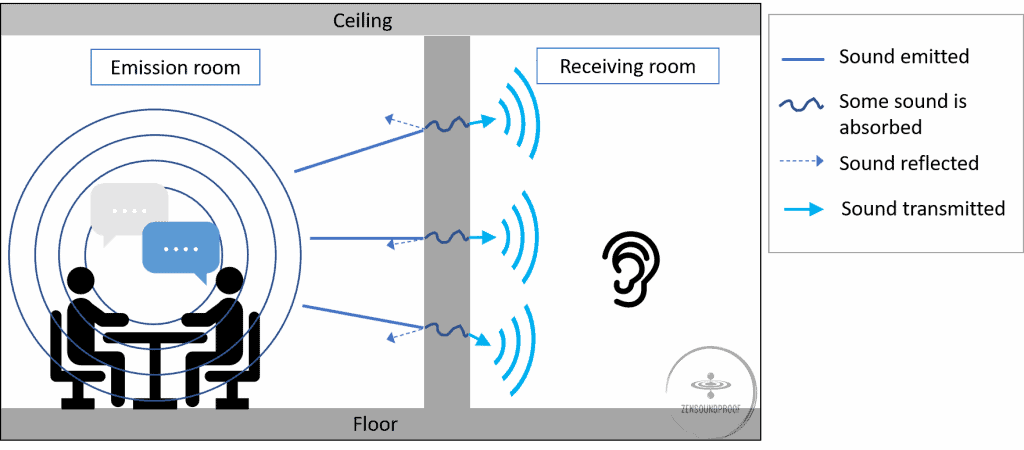
Impact Noise
Impact noise is also fairly easy to understand: it consists of sounds made through direct contact between an object and a surface. Standard examples include:
- Footsteps
- Furniture being moved
- Dropping something on the floor
Impact noise – also known as structure-borne noise – is caused by vibrations. An object hits the surface and creates vibrations, which pass through a structure and come out the other side as sound waves.

Impact noise is arguably harder to combat than airborne noise. This is because there’s usually more vibrational energy involved, but it’s still possible to block or reduce.
STC
Along with knowing the main types of noise pollution, it’s worth understanding the ratings you apply to structures. For this kind of job, the main ones are STC and IIC.
STC stands for Sound Transmission Class. It’s a rating that determines how well a structure isolates sound. Individual components will have their own STC, but it’s more important to consider a structure’s overall rating.
As this chart shows, the higher the STC rating, the more effectively a structure isolates noise.
| STC | Example of noise level |
| 25 | You can hear quiet speech clearly |
| 30 | You can hear normal speech clearly |
| 35 | You can hear loud speech clearly |
| 40 | You can hear loud speech but not understand it |
| 45 | The lowest threshold for sound privacy |
| 50 | Loud sounds become very faint |
| 60+ | Considered effective soundproofing |
A half-inch sheet of standard drywall has an STC of about 33, which, as you can see, provides little sound isolation. Dedicated soundproofing materials are most effective at improving STC.
IIC
IIC stands for Impact Insulation Class. It’s essentially a rating system for impact noise, just as STC is for airborne noise. Soundproofers use IIC for floor and ceiling assemblies.
Much like STC, the higher a material’s IIC, the better it is at absorbing and dissipating impact sounds.
IIC is applied to different products within an assembly, as I discuss in my post about floor underlays.
How to Fight Airborne and Impact Noise
We can break soundproofing down into 4 main principles. It’s worth understanding these and how they relate to the 2 types of noise pollution.
The 4 principles are:
- Mass
- Decoupling
- Absorption
- Damping
Mass
This is the most self-explanatory principle. It simply involves making a structure heavier so it doesn’t vibrate as easily. The harder a structure is to vibrate, the more difficult it is for sound waves to pass through.
Mass is most effective for combating airborne noise, but does work to an extent against impact noise.
Decoupling
Decoupling is also known as mechanical isolation. It is probably one of the most effective soundproofing methods.
It involves physically separating 2 sides of a structure so sound waves physically can’t pass through. You’re effectively removing the sound waves’ transmission path.
Decoupling is most effective against impact noise but also works well against airborne noise.
Absorption
Again, this is fairly self-explanatory. Absorption involves trapping sound waves within a material, converting their vibrational energy into heat energy in the process.
Sound waves hit the material and cause it to vibrate at a molecular level. This process converts the waves’ mechanical energy into heat.
Absorption is most effective against airborne noise and makes no difference to impact noise.
Damping
Damping involves dissipating vibrational energy before it can become sound waves.
There are various ways to achieve this, but the most effective is to use noise-damping compounds like Green Glue.
Damping is effective against impact noise because it prevents vibrations from radiating as sound waves after passing through a structure.
Which Principles Should You Use?
When soundproofing a ceiling, it’s best to use all 4 principles if possible. Each offers benefits while counteracting weaknesses found in the others.
Suspended ceilings are relatively common in working spaces, basements, and commercial buildings, which gives you a good starting point for soundproofing.
We’ll see in the next section how you can decoupling in place otherwise.
Consider your timeline and budget and decide which would be best in your particular situation.
Types of Ceilings
Now that we understand the types of noise pollution, it’s worth considering what type of ceiling you’ll be working with. Only then can you work out which soundproofing methods you can try.
In your home you’ll likely have 1 of 2 main types.
Drywall
Drywall consists of panels made from gypsum and paper. It’s cheap and easy to install, but isn’t known for its soundproofing qualities.
As I mentioned above, it has quite a poor STC rating. This is because drywall is thin and light, but also because the boards are screwed to the joists of the floor above. Fixing them in this way offers an excellent path for sound transmission.
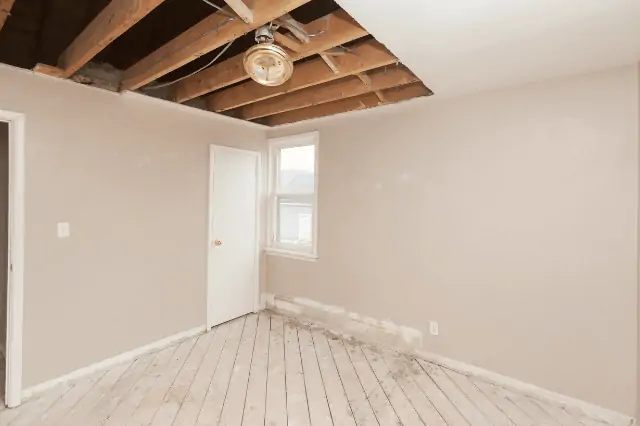
But for ceiling soundproofing, it’s a good starting point because it’s easy to adapt and insulate as you see fit.
Suspended or Dropped
Dropped ceilings are secondary ceilings hung from a main ceiling above. This might be the building’s main ceiling or an upper floor. You’d typically find them in building conversions, retail spaces, or basements of residential buildings.
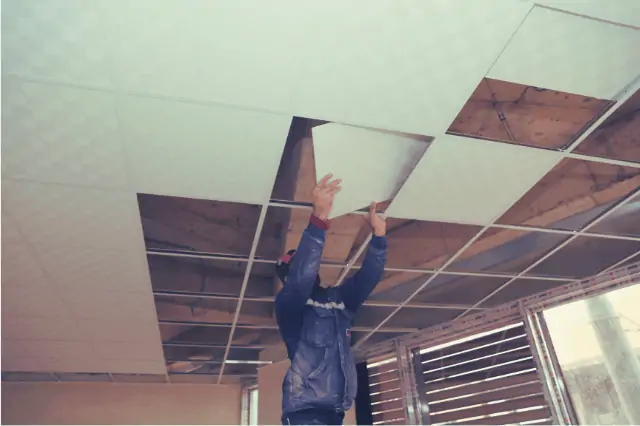
They’re useful for soundproofing because you’ve got much of a decoupling setup in place, and plenty of room for insulation. But this cavity is often home to things like wiring, lighting and ventilation ducting. These components all offer effective sound transmission pathways.
4 Ways – How to Soundproof a Ceiling
To soundproof a ceiling, start by deciding what you’re working with, your budget, and your DIY skills. All these options involve some kind of installation, so you’ll want to be a bit handy.
1. Decouple the ceiling – STC 66
Decoupling is one of the most effective methods of ceiling noise reduction. But it’s also the most invasive.
You’ll need a double-layer of drywall sandwiched together with Green Glue, resilient clips, and furring channels. The method is as follows:
- Remove the existing drywall ceiling.
- Screw resilient sound isolation clips to ceiling joists.
- Snap resilient furring channels into resilient clips. (Learn more about the different types of resilient channels here)
- Screw the double layer of drywall to furring channels. Note: Make sure the screw doesn’t reach the joist; it should only be in contact with the drywall and the furring channel.
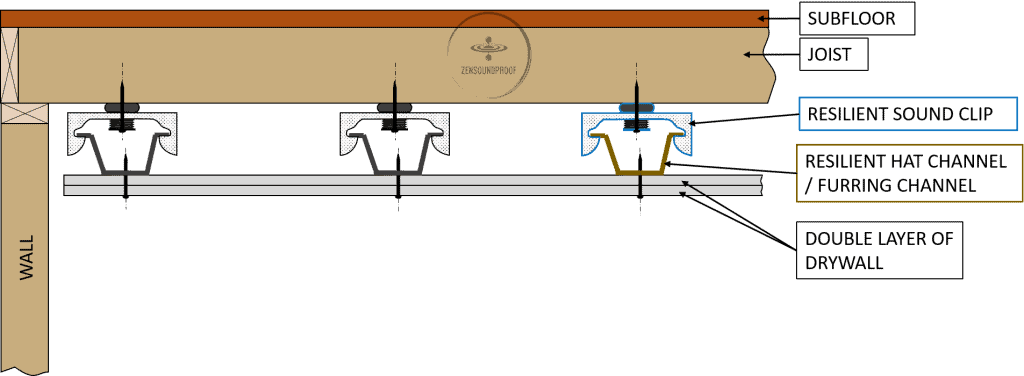
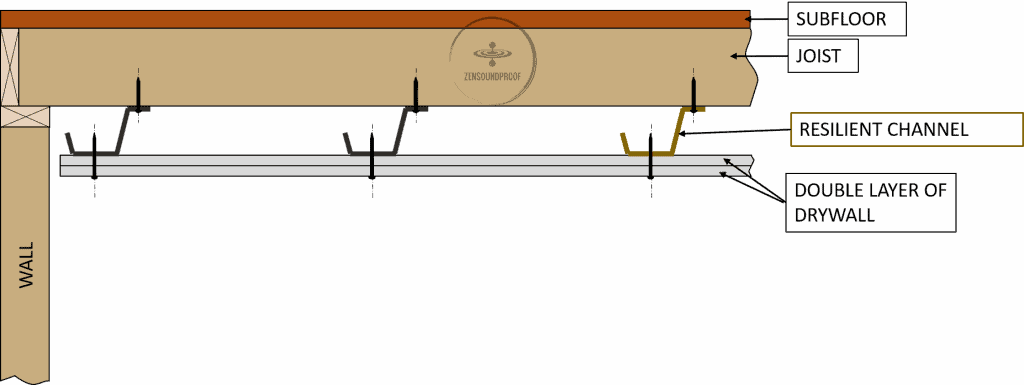
You can also insulate the ceiling cavity with mineral wool or fiberglass insulation if you wish.
Check out this video for a visual guide and details on channel spacing. Or, you can directly check the spacing recommendations from the manufacturer PAC International here (see page 4).
2. Add another layer of drywall – STC 38-49
Adding another layer of drywall to the existing ceiling is probably the cheapest and quickest method. But as you can see from the STC, it doesn’t make a massive difference.
You can improve this option by sandwiching the layers together with a sound-damping compound, such as Green Glue.
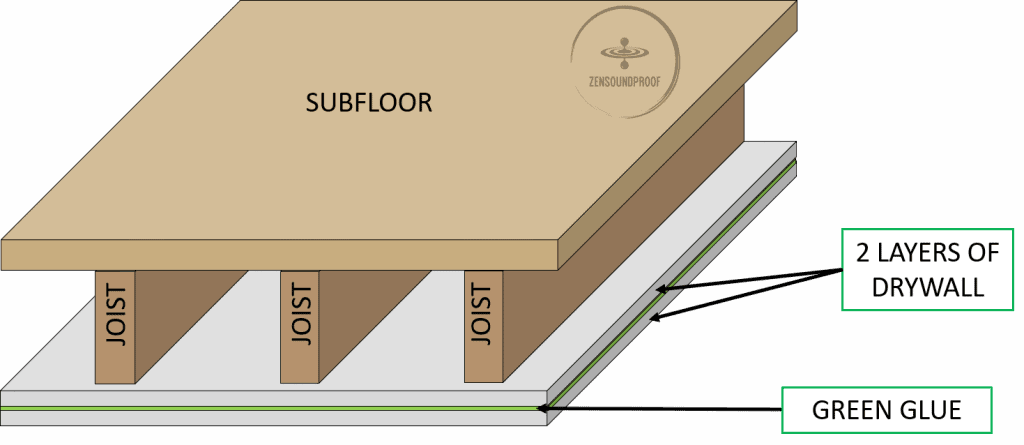
Drywall comes in different thicknesses, so aim for the thickest type possible. Standard thickness used for ceilings are 5/8 inch.
Using soundproof drywall will improve this option, but will also make it considerably more expensive. Soundproof drywall usually features a layer of mass loaded vinyl, but at a significant cost.
3. Add insulation to the ceiling cavity – STC 36-49
This option should be used alongside any other changes you make to the ceiling or floor. Cavities are great echo chambers and can make sounds appear louder as they bounce around the hollow space. To counter this effect, sound absorbing materials are the way to go.
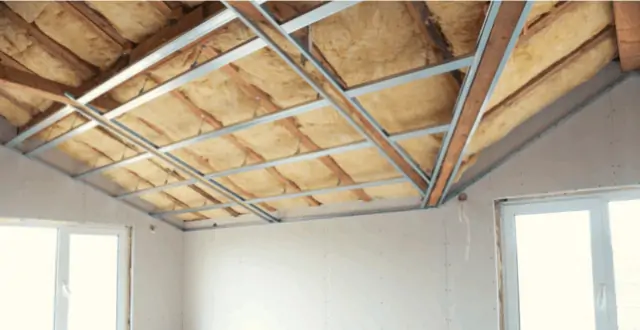
By adding this type of materials, you can insulate the cavity between a drywall ceiling and the above floor joists. But you might not be able to fit much insulation in the cavity, as it might be fairly small.
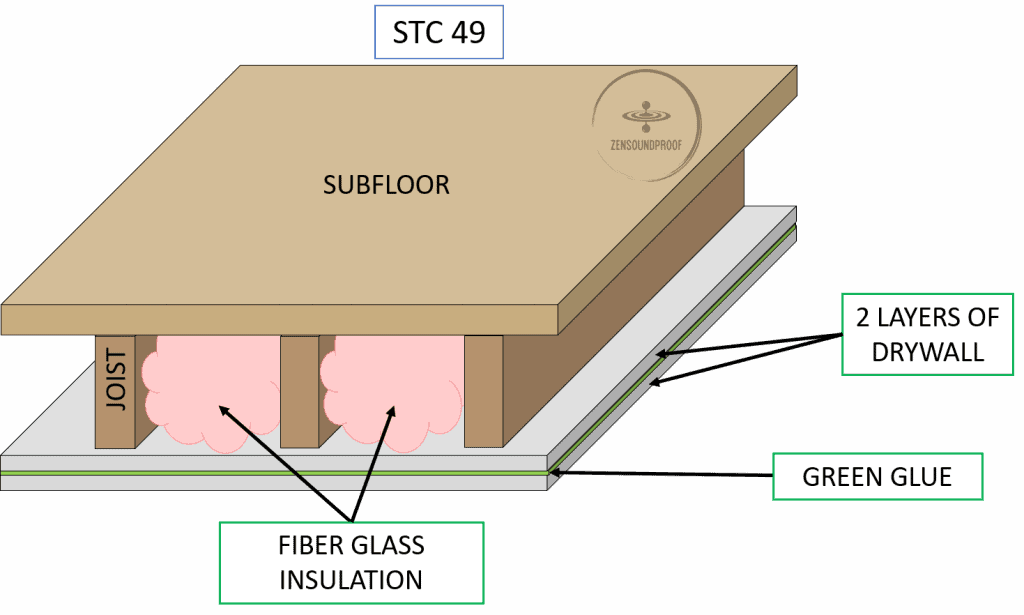
Different types of insulation offer different STC ratings. All the below materials have excellent NRC ratings, meaning they are good at absorbing sounds. The most common from less to more efficient are:
- Blown-in fiberglass
- Fiberglass batts
- Closed-cell spray foam
- Rock or mineral wool
For best results, your insulation should be around 3” thick, not compressed in the cavity, and supported by other soundproofing materials for ceilings.
You can add insulation to dropped ceilings too. Using something like mineral wool insulation is recommended, as not only is it efficient at absorbing sound but it also provides good fire resistance.
4. Soundproof the floor above – STC up to 72
Granted, you might not have access to the floor above. But if you do, adding some soundproofing materials there is much more effective against impact noises.
Damping or insulating against them at the source means less vibrational energy passes into the structure.
For best results, combine one (or more) of these options with ceiling soundproofing.
Here are my main choices for combating impact noise on the floor above.
Mass loaded vinyl
Mass loaded vinyl (MLV) is a particularly useful soundproofing product. It helps to block sound by adding limp mass. This means that it doesn’t transmit sound waves because it doesn’t vibrate.
Therefore, it adds both mass and damping.
Fit a layer either under the carpet or above the subfloor. It comes in different weights, so go for 2lb per square foot – the highest.
Acoustic floor underlay
As the name implies, this is a specific kind of floor underlay that provides sound damping qualities. You can use it under all floor types too, so it’s fairly versatile.
I discuss the best types of soundproof floor underlay in a different article, so check that out for more information.
Pay attention to the underlay’s IIC if the information exists.
Thick rugs
Thick carpets or rugs help to dampen impact noises and are relatively inexpensive. Of course, their efficacy isn’t comparable with actual soundproofing products.
But if you’re on a budget or want a temporary solution, they’re definitely a viable option.
You May Also Wonder
How to soundproof a ceiling without construction
To soundproof a ceiling without construction, simply apply drywall or mass loaded vinyl to the existing structure. You should also focus on blocking holes and gaps in the ceiling using acoustic caulk such as Green Glue.
How to soundproof a basement ceiling
The easiest way to soundproof a basement ceiling is to focus on the floor above. Failing that, install plenty of dense materials, and decouple the basement ceiling if possible like explained above.
How to soundproof a ceiling in an apartment
The best way to soundproof a ceiling in an apartment or condo is to fit your own decoupled drop ceiling, which you can then insulate with lots of mineral wool. This will allow you to create your own ceiling cavity between you and impact noise from above.
The truth on how to reduce noise from upstairs neighbors
Short of soundproofing your ceiling, the truth is that simply asking your neighbors is the best way to reduce noise. It can be unreasonable to ask them to install soundproofing solutions in their home, but having an honest conversation about noise levels can be constructive if done right.
How much does it cost to soundproof a ceiling?
The cost of soundproofing a ceiling depends on your chosen method. It can cost under $100 if using drywall, or a few hundred if you want to decouple the ceiling. The more expensive methods involve more components but are usually more effective. Check here to learn about ways to soundproof on a budget.
Final Thoughts on Soundproofing a Ceiling
Hopefully this guide has given you some useful information on how to soundproof a ceiling. As you can see, there are a few options available depending on your budget, ceiling type, and skill level.
My top recommendation is to decouple the ceiling because this combats both impact and airborne noise. If this isn’t possible, just try to add as much mass and damping as possible.
Do you have any helpful tips on soundproofing a ceiling? Let me know in the comments below.
